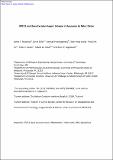| dc.contributor.author | Svilar, David | |
| dc.contributor.author | Wang, Xiao-Hong | |
| dc.contributor.author | Lin, Ying-Chih | |
| dc.contributor.author | Sobol, Robert W. | |
| dc.contributor.author | Mutamba, James Tendai | |
| dc.contributor.author | Prasongtanakij, Somsak | |
| dc.contributor.author | Dedon, Peter C | |
| dc.contributor.author | Engelward, Bevin P | |
| dc.date.accessioned | 2017-05-02T18:29:03Z | |
| dc.date.available | 2017-05-02T18:29:03Z | |
| dc.date.issued | 2011-10 | |
| dc.date.submitted | 2011-10 | |
| dc.identifier.issn | 15687864 | |
| dc.identifier.uri | http://hdl.handle.net/1721.1/108607 | |
| dc.description.abstract | Inflammation associated reactive oxygen and nitrogen species (RONs), including peroxynitrite (ONOO−) and nitric oxide (NOradical dot), create base lesions that potentially play a role in the toxicity and large genomic rearrangements associated with many malignancies. Little is known about the role of base excision repair (BER) in removing these endogenous DNA lesions. Here, we explore the role of X-ray repair cross-complementing group 1 (XRCC1) in attenuating RONs-induced genotoxicity. XRCC1 is a scaffold protein critical for BER for which polymorphisms modulate the risk of cancer. We exploited CHO and human glioblastoma cell lines engineered to express varied levels of BER proteins to study XRCC1. Cytotoxicity and the levels of DNA repair intermediates (single-strand breaks; SSB) were evaluated following exposure of the cells to the ONOO− donor, SIN-1, and to gaseous NOradical dot. XRCC1 null cells were slightly more sensitive to SIN-1 than wild-type cells. We used small-scale bioreactors to expose cells to NOradical dot and found that XRCC1-deficient CHO cells were not sensitive. However, using a molecular beacon assay to test lesion removal in vitro, we found that XRCC1 facilitates AAG-initiated excision of two key NOradical dot-induced DNA lesions: 1,N[superscript 6]-ethenoadenine and hypoxanthine. Furthermore, overexpression of AAG rendered XRCC1-deficient cells sensitive to NOradical dot-induced DNA damage. These results show that AAG is a key glycosylase for BER of NOradical dot-induced DNA damage and that XRCC1's role in modulating sensitivity to RONs is dependent upon the cellular level of AAG. This demonstrates the importance of considering the expression of other components of the BER pathway when evaluating the impact of XRCC1 polymorphisms on cancer risk. | en_US |
| dc.description.sponsorship | Massachusetts Institute of Technology. Center for Environmental Health Sciences (NIEHS P30-ES002109) | en_US |
| dc.description.sponsorship | National Institutes of Health (U.S.) (NIH grant P01-CA026731) | en_US |
| dc.description.sponsorship | National Institutes of Health (U.S.) (NIH grant 2-R01-CA079827-05A1) | en_US |
| dc.description.sponsorship | National Institutes of Health (U.S.) (NIH Grant U01-ES016045) | en_US |
| dc.description.sponsorship | National Institutes of Health (U.S.) (NIH Grant GM087798) | en_US |
| dc.description.sponsorship | National Institutes of Health (U.S.) (NIH Grant CA148629) | en_US |
| dc.description.sponsorship | National Institutes of Health (U.S.) (NIH Grant ES019498) | en_US |
| dc.description.sponsorship | National Institutes of Health (U.S.) (Cancer Center Support Grant P30 CA047904) | en_US |
| dc.language.iso | en_US | |
| dc.publisher | Elsevier B.V. | en_US |
| dc.relation.isversionof | http://dx.doi.org/10.1016/j.dnarep.2011.10.008 | en_US |
| dc.rights | Creative Commons Attribution-NonCommercial-NoDerivs License | en_US |
| dc.rights.uri | http://creativecommons.org/licenses/by-nc-nd/4.0/ | en_US |
| dc.source | Prof. Engelward | en_US |
| dc.title | XRCC1 and base excision repair balance in response to nitric oxide | en_US |
| dc.type | Article | en_US |
| dc.identifier.citation | Mutamba, James T., David Svilar, Somsak Prasongtanakij, Xiao-Hong Wang, Ying-Chih Lin, Peter C. Dedon, Robert W. Sobol, and Bevin P. Engelward. “XRCC1 and Base Excision Repair Balance in Response to Nitric Oxide.” DNA Repair 10, no. 12 (December 2011): 1282–1293. | en_US |
| dc.contributor.department | Massachusetts Institute of Technology. Department of Biological Engineering | en_US |
| dc.contributor.approver | Engelward, Bevin P | en_US |
| dc.contributor.mitauthor | Mutamba, James Tendai | |
| dc.contributor.mitauthor | Prasongtanakij, Somsak | |
| dc.contributor.mitauthor | Dedon, Peter C | |
| dc.contributor.mitauthor | Engelward, Bevin P | |
| dc.relation.journal | DNA Repair | en_US |
| dc.eprint.version | Author's final manuscript | en_US |
| dc.type.uri | http://purl.org/eprint/type/JournalArticle | en_US |
| eprint.status | http://purl.org/eprint/status/PeerReviewed | en_US |
| dspace.orderedauthors | Mutamba, James T.; Svilar, David; Prasongtanakij, Somsak; Wang, Xiao-Hong; Lin, Ying-Chih; Dedon, Peter C.; Sobol, Robert W.; Engelward, Bevin P. | en_US |
| dspace.embargo.terms | N | en_US |
| dc.identifier.orcid | https://orcid.org/0000-0003-0011-3067 | |
| mit.license | PUBLISHER_CC | en_US |
| mit.metadata.status | Complete | |
